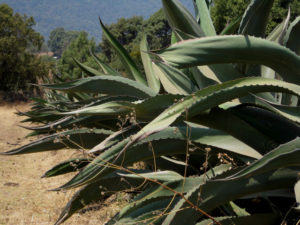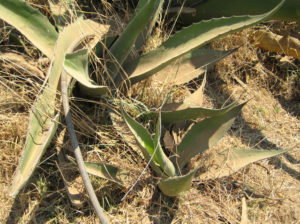Part Two: Classist forces target pulque
If pulque can create such positive results in all of our daily lives, why is it in danger of extinction? What happened to pulque? It appears to be the victim of “classism,” which can be defined as “the systematic oppression of subordinated class groups to advantage and strengthen the dominant class groups” (Class Action).
The name itself bares the scar of classism. The word pulque comes from the word poliuqui, which means “rotten.” It appears that the conquistadores — many of whom believed themselves to be greatly superior to the native people — heard the phrase octli poliuqul (rotten pulque) when used by indigenous people to refer to bad pulque, and began to call the drink by this adjective, rather than its name.
Of course, this possibly unintentional slander is not the reason so few drink it today. Like so many things related to indigenous cultures in the Americas, pulque was directly and deliberately attacked.

© Julia Taylor, 2011
Pulque sustained a many-year boom, after which a campaign against the drink was begun during the regime of Porfirio Díaz. Later, President Álvaro Obregón, in his interest in opening the market for beer bottling companies, created a negative campaign against pulque, claiming that its producers used cow feces to ferment it.
During the presidency of Lázaro Cárdenas (1934-1940), anti-alcoholic campaigns were organized with the objective of completely abolishing the consumption of pulque.
These were the beginnings of classifying pulque as the drink of poor people and beer the ideal beverage for the rich.
The irony is that beer is now the binge beverage of choice. When pulque is consumed today, it is usually in the setting of a relaxed social session. If the session extends toward drunkenness, someone goes to the store for beer.
It does appear to be true today that more poor people than rich are still enjoying pulque.
In central Mexico, pulque is a minor aspect of the general experience of marginalization. The consumption of pulque can stigmatize the drinker, but on the other hand those same drinkers enjoy a flavorful connection to the advanced culture of their ancestors. My Mexican husband says that he’s heard some people hold up their glass of pulque and say, “This is the drink of the gods.” Apparently, this statement attempts to reverse the classist slander and re-draw the speaker’s connection to their cultural heritage. This statement seems to say, “Our drink comes from a proud tradition and there is no reason for us to feel marginalized.”
The deliberate marginalization of pulque has been greatly successful on a society-wide level, despite a few die-hard pulque supporters, mostly in Mexico City. A 2004 study of students attending the Universidad de las Americas in Puebla found that while eighty-two percent of those surveyed go out to places where they consume alcohol, only sixty percent had even tried pulque, the majority of these being men (Castellanos 54). The three reasons for not having tried pulque, among those who hadn’t were, because it didn’t catch their interest, because they had never seen it, or because they had a bad image of it (Castellanos 55). It doesn’t appear that any of the students consumed pulque regularly. The results of this survey indicate that at best, pulque is not of interest or not available, and at worst, viewed in a negative light.

© Julia Taylor, 2011
BBC News’ article titled “Mexico’s Ancient Drink under Threat,” ends with the ironic statement: “Unless new markets are found, this legendary pre-Hispanic beverage could be consigned to Mexico’s museums” (Marshall). Of course, beverages aren’t regularly consumed in museums — especially not the fermented kind, which must be continuously tended. This leaves the development of new markets as the way to reverse the damage done to pulque.
Why cry for its loss?
Nowadays, most people in central Mexico have forgotten the slander campaigns, and many have even forgotten pulque. Sometimes those who still enjoy it, do so almost secretly.
I remember once we were enjoying a lively conversation with someone. It was the kind of exuberant, extended conversation on which new friendships can be founded. One of our new acquaintances lowered his voice and asked, “Do you drink pulque?” Like many younger people in central Mexico, my husband hadn’t yet tried it, even though his older relatives were familiar with it. At the time, we were ignorant of pulque’s extensive socio-political baggage and my husband simply answered that no, we didn’t drink it. The questioner quickly backpedaled and even though my husband tried to show his willingness to try new foods and drinks, the person just told us to forget it. I was left with the impression that pulque was some sort of dangerous substance and forgot about it for a time.
So, why did I, a life-long abstainer from alcoholic beverages of all types, later pick up the thread and write an article on a dying alcoholic beverage? Why care if pulque — which has been the drink of choice of many severely alcoholic people — disappears from the face of Mexico’s mountainous terrain? There are many answers to this question and each person who still enjoys it today will have his or her own answer.
Pulque isn’t empty calories, as in beer
Firstly, pulque is celebrated among its supporters for being nutritious. As a fermented beverage, the natural nutrients available in the aguamiel aren’t destroyed in the production process, rather they are enhanced. Don Lotter reports that
“[d]uring the fermentation the vitamin content (milligrams of vitamins per 100g of product) of pulque increases from 5 to 29 for thiamine, 54 to 515 for niacin and 18 to 33 for riboflavin….” Additionally, “Lactobacilli, well known for promoting gastrointestinal health, are also active in the fermentation.”
Ian Chadwick writes that
“A study of the diet of the Otomi Indians found pulque their single largest source of vitamin C and second only to tortillas in its contribution of calories, thiamin, riboflavin, niacin, calcium, and iron. A recent dietary study in the Solis Valley found that the iron absorption-enhancing effect of pulque’s ascorbic acid makes it the single best predictor (sic) against anemia. Researchers have also inferred the presence of folic acid in pulque.”
Roberto Jiménez surmises that pulque’s nutritional value is a probable reason that older people were allowed to drink it during pre-Hispanic times. It might have helped to keep them healthier and extend their lives.
Cultural Resource
My husband reminds me that cultural traditions, such as enjoying pulque with family and neighbors, are important because they help us to maintain and share our identities. They provide an experiential connection to our roots in the places and people from whom we come, helping us remember and feel pride in our past, even giving us a way to explain ourselves to others who are of different backgrounds.
I am not Mexican, and my own answer stems from the ecological principle that diversity is necessary for survival. Indigenous cultures act as repositories of ecological knowledge and skills which have immeasurable value to all humankind.
The knowledge of maguey cultivation and use may turn out to be useful for some as-of-yet-undiscovered application, such as a sustainable resource or a medical product. In fact, in one area of Guatemala, the making of maguey-based products has helped a community survive draught and is connected to the preservation of natural dying techniques (AMO).
Of course, cultures aren’t like textbooks that can sit on a shelf for years before being plumbed for new insights. Cultures are complex systems of beliefs and knowledge, kept alive by the daily activities of the people who express them. While pulque itself may not be of interest to all of humankind, as one of the last maguey-based products still utilized in local communities, it is the main motivation for keeping magueys in cultivation. If pulque is not regularly enjoyed by the living, the knowledge of maguey cultivation and use will be buried with the dead.
Mixiotes (traditional seasoned, steamed-meat wraps) provide an example of how pulque is key to the continuation of maguey cultivation. Mixiotes were originally wrapped in maguey leaves, but with the absence of maguey leaves in urban communities, a substitute has been found. While, the flavor must be just that much richer with the original maguey wraps, the aluminum foil wrapped version is far more common. In fact, maguey-wrapped mixiotes are rare enough that I personally have never tried the original version. In contrast, the aguamiel in pulque, can’t be substituted by anything else and therefore helps to ensure the continued cultivation of the maguey.
Maybe magueys won’t provide us with the cure for HIV, but do we really want to run the risk of losing the maguey or the cultural knowledge related to its cultivation and use — especially if its loss is driven by the forces of classism? We have a lot more to gain by remaining open minded, and enjoying pulque and other maguey-derived products.
Despite much doom-saying, it is possible that the practice of maguey cultivation may survive into future generations. The maguey is still in cultivation, although in greatly reduced numbers. If new markets can be developed, it has great potential as raw material for locally crafted products. In fact, there is a rising interest in Mexico (and other countries where magueys were traditionally cultivated) for maguey-based products. For example, El Universal mentions that pulque is now used as an important ingredient in today’s gourmet menus.
In this day and age, when we are just recognizing the importance of reviving locally based economies, pulque and other maguey-derived products could be viewed as the wave of the future rather than a tether to the past.












